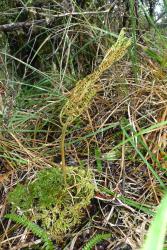Terrestrial (NZ) or epiphytic (not NZ) ferns. Rhizomes erect (NZ) or sometimes short-creeping (not NZ), protected by sheathing bases of older fronds, glabrous; roots lacking root hairs, often fleshy, occasionally contractile, sometimes proliferous (NZ) or bearing vegetative buds and gemmae (not NZ). Fronds monomorphic, not articulated to rhizome, circinate or convolute, divided into a sterile photosynthetic blade and a greatly reduced spore-bearing portion (sporophore), usually only 1 or 2 produced per season. Common stalk glabrous or hairy. Sterile blade entire or divided 1–several times, glabrous or hairy. Sporophore undivided or divided 1–several times. Veins free or reticulate. Sporangia not in sori, either sessile or subsessile on branches of a divided sporophore or deeply sunken in two rows either side of an undivided sporophore, massive, thick-walled, lacking an annulus, dehiscing along a single line, maturing ± simultaneously, with 1000s of spores per sporangium. Homosporous; spores trilete, lacking chlorophyll; perispores coarsely to finely verrucate.
A family of four genera and c. 80 species (Smith et al. 2006). The family includes two large, widespread genera, Ophioglossum and Botrychium, together with the monotypic Helminthostachys and Mankyua. The two larger genera are sometimes divided into segregate genera.
Molecular evidence indicates that Ophioglossaceae is sister to the Psilotaceae, and that they together comprise an early-diverging branch of the ferns (Smith et al. 2006). The traditional view of the family as eusporangiate is consistent with this placement. However, Kato (1988) suggested that the Ophioglossaceae are living progymnosperms, citing especially their vascular anatomy and non-circinate vernation, and later suggested that the family provided a hypothetical archetype for the angiosperm carpel (Kato 1990, 1991). Whatever their relationships, the Ophioglossaceae are very different in their morphology to other living ferns.
The family is represented in New Zealand by two indigenous genera – Ophioglossum and Botrychium.
| 1 | Sterile blade of frond dissected 1–several times; veins free; sporangia sessile or subsessile on a branched sporophore | Botrychium |
| Sterile blade of frond undivided; veins reticulate; sporangia embedded in an undivided sporophore | Ophioglossum |
The Ophioglossaceae in New Zealand comprises terrestrial ferns recognised by their fronds, which are divided into a sterile blade and a fertile sporophore. The sporophores bear sporangia that are not arranged in sori, have thick walls opening along a line of weakness, and produce thousands of trilete spores. The spores of all New Zealand species of Ophioglossaceae have been described and illustrated by Large & Braggins (1991).
Ophioglossum and Botrychium are virtually cosmopolitan but the other genera are more restricted in distribution (Wagner 1990; Smith et al. 2006). Ten species occur in Australia (Chinnock 1998). Two non-endemic genera with five species in New Zealand; two species endemic.
| Category | Number |
|---|---|
| Indigenous (Endemic) | 2 |
| Indigenous (Non-endemic) | 3 |
| Total | 5 |
The gametophytes of species of Ophioglossaceae are unusual amongst ferns in being subterranean, not green, mycorrhizal and tuberous – either flattened in Botrychium, or worm-like in Ophioglossum (Foster & Gifford 1974).




